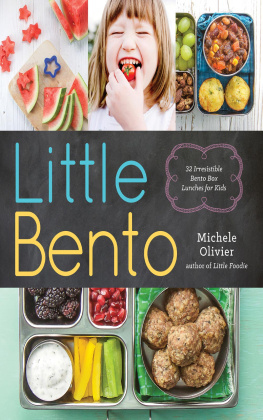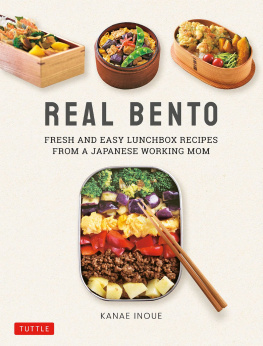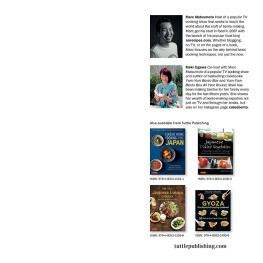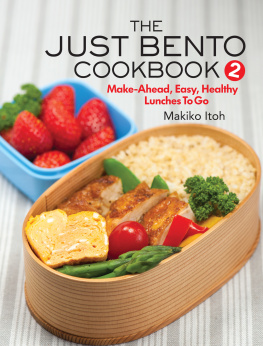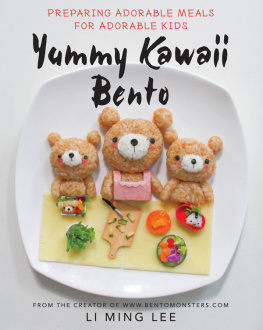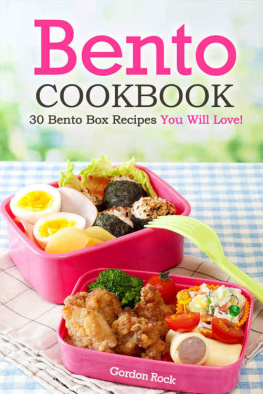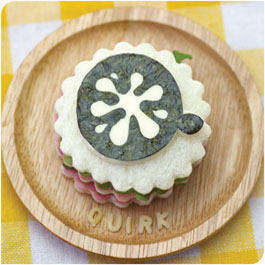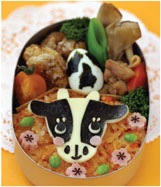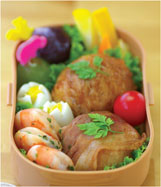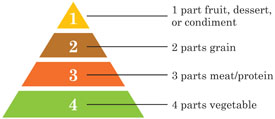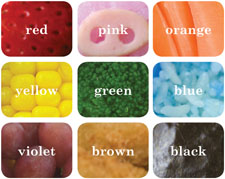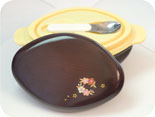Copyright 2010 Quirk Books
All rights reserved. No part of this book may be reproduced in any form without written permission from the publisher.
Library of Congress Cataloging in Publication Number: 2009943046
eISBN: 978-1-59474-650-5
Designed by Jenny Kraemer
Production management by John J. McGurk
Photography by Maki Ogawa
Author photograph by Maki's son Kai Ogawa, who wants to be a cameraman when he grows up.
Quirk Books
215 Church Street
Philadelphia, PA 19106
www.quirkbooks.com
Visit www.yumyumbento.com !
Table of Contents
Hello, Obento! An Introduction to Japanese Lunches
Japanese boxed lunches are called bento (or, reverently, obento). These yummy, healthy meals are all the rage in Japan, where mothers think of them as an expression of love for their children. Bento boxes can be made from scratch, but they are also a great way to enjoy leftovers. Children and adults alike love to eat and make character-driven bento boxes, called charaben (or kyaraben). We hope you'll mix and match the recipes in this book to create your own tasty, portable meals. Yum-Yum Bento Box is a collection of some of our favorite lunches for our children and ourselves. They are almost too cute to eat!
According to a popular Japanese saying, it is important to "Eat with your eyes." This means more than just taking time to savor lovely, appetizing foods. Small, thoughtfully arranged dishes encourage portion control. And a rainbow of fruits, vegetables, fish, meats, rice, tofu, and cheeses central to the Japanese diet have given that country's population the highest longevity and lowest obesity rate in the world.
When my son started kindergarten, he cried and cried. I hoped that my bento would make him happy!
Maki
The bento tradition dates back centuries. As early as the 1500s Japanese farmers packed lunches to eat in the fields. In the late 1800s, Japanese immigrants moved to Hawaii to work in the sugarcane fields, and they brought the bento box tradition with them. These portable lunches have become a part of the island culture and are made at home and sold in takeout restaurants, supermarkets, and convenience stores. Just ask President Barack Obama, who grew up in Honoluluhe'll know exactly what a bento is. Today, online communities are an increasingly popular forum for sharing bento-making tips and techniques. It's a fun way to show our creations and learn new tricks. Like many mothers, we enjoy preparing simple, cute character bento boxes, called charaben or "deco ben" (because they are decorated bento). In this book, you'll find three types of character bentos: Cuties & Critters , modeled after pets and pals; Fairy-Tale Friends , inspired by magical stories; and Special Day Treats , perfect for celebrating big days or brightening up tough ones.
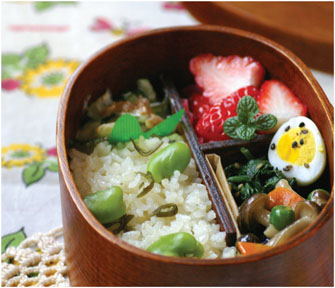
 | Traditional bento |
 | Charaben: character bento |
 | Traditional bento |
I found the online bento community and since I was starting Weight Watchers at the time, I decided to use bentos to regulate my portions. It worked!
Pikko
Lovingly made bento boxes ease Japanese children into preschool by connecting school and the outside world with comforting foods from home. Mothers get up in the wee hours of the morning to prepare special obento for their children. At school, the finished creations are shared, compared, and even judged in cafeteria competitions. Online, bento makers share recipes and photos on Flickr, forums, and personal blogs. We gather inspiration from TV animation, old postage stamps, antiques, holidays, picture books, and our childrens' drawings. Bento is a fun, creative outlet, but another benefit can't be denied. Child obesity rates around the world continue to rise at an alarming rate, which leaves parents wondering: How do we get our children to eat healthier? How do we eat healthier? With its focus on smaller portions, adorable presentation, attractive color schemes, and tasty tidbits, bento is one answer to that question. We hope this book will provide you with fresh recipes, time-saving tricks, and helpful resources for your own adventures in bento making!
Pikko & Maki
A good bento box packs in little tastes of everythingincluding occasional treats like bacon, cheese, and dessert. It's all about creatively presenting a fresh, well-balanced meal that's a delight to make and eat.
When assembling a bento box, aim for a :3:: ratio of food groups.
Making your bento look full and attractive can be accomplished with a few simple additions. There's no recipe for beautiful garnishes: Use whatever fresh, colorful fruits and vegetables you have on hand to fill the gaps and add a pop of color to your bento. Green is easily added with broccoli, parsley, asparagus, and sugar snap peas. Red is easily added with whole or cut cherry tomatoes and strawberries. To save time, boil all your veggies together, removing them individually with a slotted spoon as soon as they are cooked.
Try to include colorful foods from every hue in the rainbow in each bento box. That will ensure a healthy balance of nutrients as well as a pretty presentation.
Bento Boxes, Tools, and Accessories
A list of all available bento supplies would be endless, but there are a few key items and many inexpensive alternatives. For example, drinking straws and craft hole punches work just as well as most bento punches. Small hobby scissors are much more affordable than Fiskars micro-tip scissors. A toothpick can apply tiny whiskers to a kitty cat just as nicely as a special set of tweezers. And regular plastic storage containers can be used instead of fancy bento boxes.




